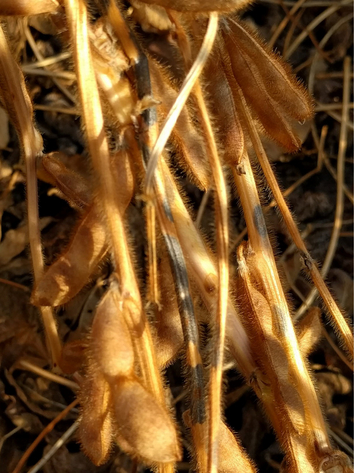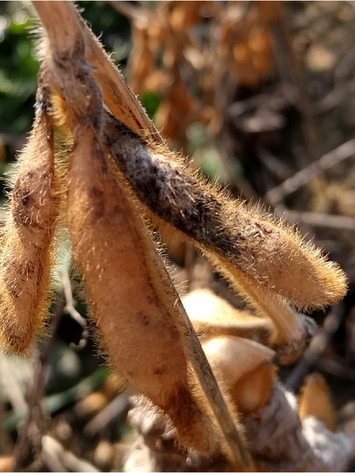Diaporthe phaseolorum on soybean
Diaporthe phaseolorum, Phomopsis spp.
Biology
Diaporthe phaseolorum belongs to the group of tubular fungi (Ascomycota).
The fungus overwinters both on seeds and on plant residues. In spring, it forms fruiting bodies (perithecia and pycnidia) on plant residues. The spores contained therein reach the plants by means of raindrops.
So far, there are four known pathogens that are assigned to the Diaporthe complex:
- Diaporthe phaseolorum var. sojae (pod and stem rot).
- Phomopsis longicolla (seed rot)
- Diaporthe phase olorum var. caulivora (northern stem rot)
- Diaporthe phaseolorum var. meridionalis (Southern stem canker)
Damage symptoms


The different pathogens show different symptoms.
Infection with Diaporthe phaseolorum var. sojae is only visible on dead plant material. It manifests itself in black dot-shaped fruiting bodies which become visible on stems and pods.
No infection characteristics are known from Phomopsis longicolla on the soybean plant. Severely infected seeds are shriveled, chalky white, and may show cracking. However, not all infected seeds show these symptoms.
Diaporthe phaseolorum var. caulivora and Diaporthe phaseolorum var. meridionalis result in brown, sunken lesions near the leaf node. Infected plants may show yellowish discoloration (chlorosis) and dead areas (necrosis) between leaf veins. The difference between the two pathogens is that the lesion of D. phaseolorum var. caulivora completely surrounds the stem.
Propagation and transmission
The fungus overwinters on both seeds and plant residues and is thus seed- and soil-borne. The spores contained in the seed reach the plants by means of raindrops, which is why infection is often found in the lower third of soybean plants. Best conditions for infection are high rainfall, warm temperatures, and high relative humidity as the seeds mature. Infestation is also encouraged by a late harvest under warm, humid conditions.
Last updated: 10.04.2025
automatically translated